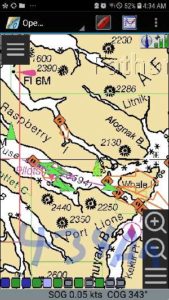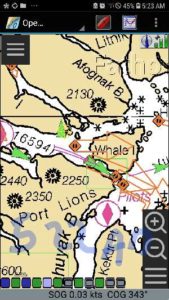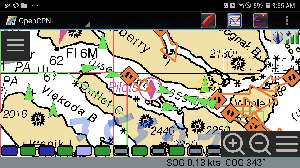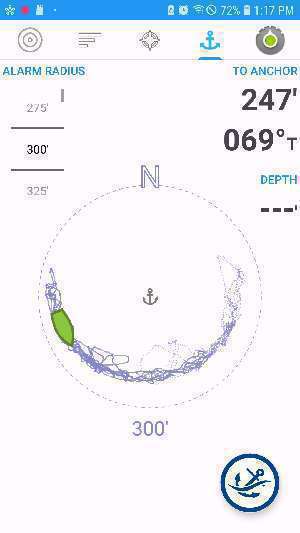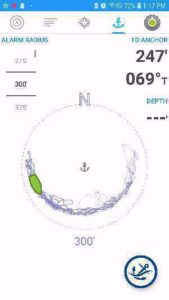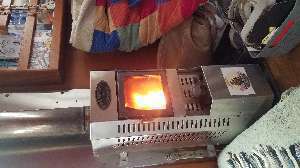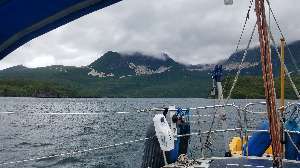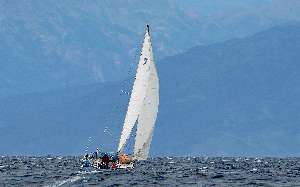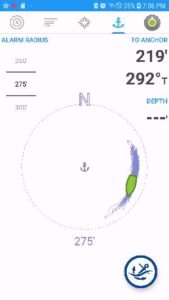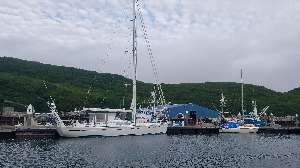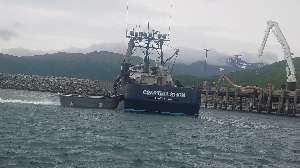Sand Point, AK, 30-JUL-2022 – We’re back in Sand Point. Jennifer wants to wait here while weather passes.
It is a different Sand Point than a month ago. The marina is empty. Less than 5% of the slips have boats. The transient dock, which is a thousand feet of dock space, has us and another non-fishing vessel and no one else.
It hasn’t been the trip Jennifer had planned. The weather hasn’t cooperated, it is true, but more importantly Jennifer hasn’t been unable to conquer her fears.
It took us only two weeks to get to Sand Point on the way down; Jennifer has left us a month to get pack to Homer. Jennifer makes our plans, she decides where we will go and how long we will stay someplace. She decides the overnight trips and where where we wait out weather. This year her fears have not been put aside, they have conquered her.
The goal was to get down to Samalga Pass where we entered the Aleutians and the push a bit west down the chain. Samalga Pass is 176 nautical miles past Dutch, the terminus of our trip this year.
The weather has been much worse this year. Days of sunshine have been few and far between, but it has been different. What has been different? Many things.
We are older, perhaps it is just age. I find that as I age, the time I have left becomes more precious. For me, I want to be certain I am doing something that I am proud of. Sailing, traveling, writing, and above all, being with Jennifer.
Perhaps it is only aging.
I see it as a combination of things: We were away from Caro Babbo for nine and half months between pulling her out in September 2020 and returning in 2021. We spent only five weeks aboard.
We all define ourselves in many ways. I began to define myself as a sailor, and while Jennifer never did, we defined ourselves as living close to half time aboard a boat. Those threads to that self definition began to fray; there are less of them now.
Jennifer has been reading the Caro Babbo log from 2020 when we sailed from Hawaii and then up the chain. She confided her fears there. She tells me reading it has been a bad thing to do. It compounds the fears she has.
There are also meta fears. Jennifer is feeling shame that she can’t overcome her fears and this is the worst of all.
I see a bunch of things as different this year: – We have spent more time in towns at docks than we have away from them. We are around people and we have been in daily communications with the outside world, something we never do. It means that we haven’t built the world that is the two of us: the micro-culture that is John and Jennifer alone, sailing, visiting new places and being self reliant.
– We don’t live alone anymore in Port Townsend. We live with two women who are having a hard time achieving success in the world. They have each moved in with us while they separately regroup. They are not being successful – I’m sure each will be – but I wonder if that lack of success sets standard of success to be expected. *
– We have been traveling in the company of much bigger boats. Generally, when we meet sailors they are sailing on boats that are not terribly larger than ours, always less than forty feet. Even the large the Amels that we meet, which are over fifty feet, are eighties designs: they have the same proportions we do. Alumni, owned by Hans and Sylvia, and Inook, owned by Laurent, are late 201x boats. The proportions are huge. There are 60 feet and forty-six feet respectively, but sailboats from that time carry the widest part of their beam aft, and they are easily twice as tall above the water line as boats from the 80s; they dwarf their length counterparts.
From ashore in Dora Harbor, Caro Babbo looked like a child’s scale model trailed out behind Alumni.
– For the first time, Jennifer’s fears have rubbed off on me. This never happens. Yesterday I realized it and hope I have broken free. It showed in that I would shy away from sailing, motoring instead.
Jennifer has focused on her fear that something will happen to me when I am working on the deck. [I am tethered to a ¼” dyneema jack line, encased in tubular nylon webbing.]
I don’t know what support Jennifer gets from the outside for these ventures. A very dear friend abraded me once for picking these journeys and forcing Jennifer to go on them, when I neither pick the destinations, nor the schedule.
As a man, the world supports and applauds what we do. My male friends are frankly slack-jawed that such a woman as Jennifer even exists in the world. Do Jennifer’s friends instead see this as foolhardy recklessness at the hands of a man that will bring her to an icy death? –
And death has been coming closer. In 2020, our friend Greg James died when he fell off his boat while preparing to enter a harbor in Australia after single handing from the Marshall Islands.
On this trip, a deckhand told Jennifer and me the harrowing story of being one of two survivors of a fishing boat that went down. He held his captain in his arms as the captain died from hypothermia.
And we learned that a sailing friend lost his crew off his 20-something-foot sailboat off the coast of Greenland some years ago. (There is a fourth incident that escapes me at this moment.)
So, yes, death is closer than it has been.†
Yesterday, we moved from Dolgoi Island to Sand Point. The wind, though predicted to be calm, blew at 10-15 knots all night; Jennifer was terrified that we might drag. She was worried that the bottom might be weeds and that anchor would not reset when the wind or tide changed. We have anchored in winds of 40+ knots on multiple occasions. The anchor holds fine. [Because the pressure of the wind acts upon the area it is pressing against, each time the speed of the wind doubles, the pressure goes four-fold, so 40 knots is 16 times more pressures on Caro Babbo and her anchor tackle than ten knots.] So the fear is unfounded, and that is the problem, dealing with a fear that we know is unfounded. The fear did rub off on me.
Suddenly, as if a shade had been lifted from my eyes, I saw my half-inch nylon anchor rode as a mere thread attaching us to our anchor, when everyone else uses chain – never mind that the nylon line is stronger than the 5/16-inch chain that our peers use, or that chain is nothing but short pieces of single strand wire that has been bent and then welded into a series of loops. As I reminded myself that nylon rode is better than chain (expert opinions notwithstanding), the doubt dissipated, but it had been there, leaving me laying, wide-eyed in the forepeak for some time.
This year we are using a very wonderful and trustworthy anchor drag feature in our Vesper AIS. Should we drag outside a defined radius from where we dropped the anchor, an alarm by the companionway sounds.
In Dolgoi harbor, I set the radius tightly to keep an eye on things. We had many hundreds of yards we could drag safely. The alarm went off at 2:21 am: we had dragged twenty feet while the anchor reset. It was reassuring to see that everything worked as it should, but is was my fault for making such a tight perimeter, Jennifer had trouble sleeping the rest of the night.
The next day, yesterday, was to have been 10-15 knots building through the day. Good sailing weather. We had 65 nautical miles to travel at a planned 5 knots, twelve to thirteen hours. Leaving at 7am, we should be there at 8pm.
Two days earlier we had overcome to suspected problems, each caused by me.
Sailing from Dutch we learned that I had incorrectly preserved (pickled) the water maker – it was refusing to draw water. During the work to fix that, I bumped a switch that disconnects the negative ground wire from the engine.
It took thirty minutes to discover the flipped switch, but when we went to move from Captain’s Harbor to Dolgoi, a slipping fan belt tripped a warning light on starting the engine.** The light went off and I replaced that fan belt in the harbor at Dolgoi Island – engine work in a remote place is always concerning, if something goes wrong… Jennifer volunteered that she would take the dinghy to the entrance of the harbor and using the handheld VHF radio call for help if we became disabled – ignoring that we could sail out. When she told me, I countered we could just call them on the Caro Babbo’s VHF. We’d been hearing vessels calling each other. There is reason for concern and contingencies and reason for fear.
I had two spare fan belts and installed one in a little less than fifteen minutes including locating the spares and getting the tools.
Our sailing has changed on this trip to Dolgoi and other trips. Especially on trips where there really is a reason for arriving by a certain time, generally darkness, we motor when sailing will move us less than our target 5 knots.
We came out of the harbor to complete calm, overcast skies and water that changed back and forth from orderly waves to confused seas. We motored for five hours before the wind came up enough to give us five knots.
Jennifer has voiced her fears for me and herself when I do deck work. Without roller reefing I go to the point of the bow to raise, lower and make head sail changes. It isn’t done much any more on pleasure boats but gives us the proper sail for each condition… it may contribute to why Caro Babbo is a such a fast boat: the right sail. Jennifer’s fears made me shy of going up front, or even on deck, at the beginning of the trip. That has passed as I repeatedly do so and notice everything that makes it safe, including the ability to stand in bow locker, hip deep, if I feel that is the safer place from which to work. BUT, I am often not visible from the cockpit when I am working at the bow.
The deck work was easy and as simple as it gets: easily done.
After four of so hours, the wind died, I dropped the genoa and we continued to Sand Point and a harbor quiet, deserted and empty of the life of sailing vessels waiting for an opening.
Only professionals dock boats as well as Jennifer docks Caro Babbo, and no one docks better. Jennifer docked at the end closest to the harbor entrance, bow out, before we took a walk along the dock where she decided she would rather be tucked in close to the shore in front of a dive/research vessel that would block us from the wind Jennifer expects to arrive Sunday evening. We untied, and re-docked.
Like a political echo chamber, catching Jennifer’s fears gives credence to those fears and amplifies both hers and mine.
While Jennifer lay in bed this morning, I asked her about all of this. She felt ambushed; I suppose she was justified. She listened and we discussed for a bit. She gave me credence for recognizing her fears and then dismissed it all saying, ‘‘But, I’m here.’’ Followed by the non-verbal equivalent of, ‘‘I love you, now shut up.’’
Like so many things the person we love suffers, I can’t take her fears from her and carry them instead.
Jennifer makes these plans for us and does her best to carry them out. Her decision to not move past Dutch is within her role as navigator and prudent mariner.
While lying in bed, she told me she thought it might have been a mistake not to anchor out last night in a nearby anchorage. My reply was that it might have been overly cautious, but it was not a mistake. Mistakes have bad consequences. We are prudent sailors. If we stay in and bad weather does not show up, we have not made a mistake. If we go out and bad weather show up and breaks our boat, then we have made a mistake.
After we re-docked. We went below. I made a movie-watching meal of pigs-in-blankets (hot dog quarters wrapped in baking powder biscuit dough and baked), canned chili con carne, and cole slaw using Cardini’s Caesar dressing – this may all be shock to those who have eaten dinner with us, but when no one sees, I will cook like this – and watched Glazer and Howards’ Jon Larson musical Tick, Tick, Boom – neither Jennifer nor I can recommend it enough. It seems movie musicals are back!
* Though one has made the first concrete successful step. The other has been over the past two years building the difficult platform to starting success.
† In each of these three cases we quickly understand the cause of the death, each was easily recognizable at the time and each would have been prevented with routine safety steps that Jennifer and I take. In the pleasure vessels merely attaching to a jack line would have saved the sailor on Greenland and Greg James, though with Greg, was the being in the water what killed him, or did he have a heart attack or stroke that led to him falling into the water? This fishing boat capsized because she was too top-heavy from ice and overloading. Having said all of this, accidents happen in moments. There have been more than one occasion where I was certain I was clipped in, only to find that I was not.
** It’s difficult to see this as a coincidence. In fact, flipping that switch should have mortally injured the alternator and it did not. Is there some sort of the safety circuit in this alternator? The penultimate owner spared no expense on the things he installed. The light on the engine console flashed for fifteen or more seconds before becoming a bright steady light, then dimming and going out. I need to research this.
Find our location at Carobabbo.com along with blog posts


